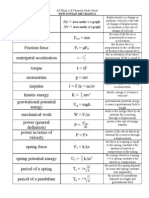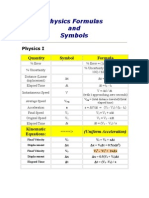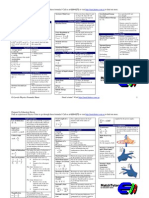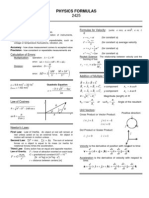Physics I Final Cheat Sheet
Uploaded by
Jsea2011Physics I Final Cheat Sheet
Uploaded by
Jsea2011Physics I Review Sheet Vectors Vectors (velocity) has BOTH magnitude and direction Scalars (speed) has magnitude
de ONLY *time, mass, volume Metric System Abbr. Mm - km - hm - dkm - m dm - cm - mm - Mm(E-6) - nm(E-9)
-------------------------------------------------------------------------------------------------------
4.
opposes motion which causes decelleration static starting Ff not moving (rolling) greater force than kinetic kinetic moving (rolling, sliding, fluid)
5.
Mult. Component Vecctors 1. 18m due S 2. 22m, 47deg. S of W 3. 10 m, 78deg. N of W 4. 30 m due E *(W&E) Sum of the V= (0)+ (-22 cos47)+(-10 cos78)+(30) =12. 9m *(N&S) Sum of the V= (-18)+ (-22 sin47)+(10 sin78)+(0) =-24. 3m *Resultant = ((12. 9)2 + (24. 3)2)1/2 =27. 5m * = tan-1(24. 3) (12.9) = 62.0deg R= 28m, 62deg S of E
-------------------------------------------------------------------------------------------------------
Equilibrium Translational: the sum of forces equal zero Rotational: the sum of torques equals zero Complete: must have BOTH Center of Gravity : center of distribution of mass Torque Force with leverage causes rotation Leverage: distance from fulcrum to force *Directly related to torque = F (perp.) l
--------------------------------------------------------------------------------------------------------
U = m g h (J) (W = F d) When not given distance(or force) W = m 2 - m o2 (W = K) (K final) (K initial) Conservation of Energy Energy change from one to the other w/o any net loss UTOP = KBOT (mgh = 1/2mv2) If you have this N lb. N Kg lb. Kg Do this .225 .225 9.8 9.8 .454 .454 To get this lb. N Kg N Kg lb.
Circular Motion Moving at a constant speed while accelerating A = v speed: constant dxn: constantly changing Centripetal Acceleration Inward seeking Ac = 2 . r Centripetal Force Causes centripetal acceleration Fc = m Ac (F = m a) Fc = m 2 . (N) r You MUST have cent. F to keep something moving in a circle Centrifugal: bodys interpretation of cent. F DOES NOT EXIST feels inertia Rotation: spinning on axis within object Revolution: spinning on axis outside of object Linear / Angular Linear : speed = distance / time radius matters 57. 3deg = 1 RADIAN 1 rotation = 2 Radians = 360 degrees Angular: speed = # rotations or revolutions / time radius does NOT matter * by doubling the angular speed you double the # of rotations Linear Angular (m) =r (RAD) (m/s) = r (RAD / s) a (m/s/s) a = r (RAD / s / s) F (N) Ft = (Nm) Mass (m) I (mr) F=ma =I For linear =o+t See other corner = o + o t + t 2 = o + ( + o) t 2 = o 2 + 2 ( - o) Rotational Inertia Resistance to begin or stop rotation Depends on amount of mass AND where it is placed Solid Sphere 2/5 mr2 Solid Disk mr2 Hollow Sphere 2/3 mr 2 Hollow Disk 1 mr2 Velocity is indirectly related to Inertia Shape of object spinning makes the difference while spinning 3 Forces acting upon an object in circular motion
Incline Graphs
Kinematics Displacement If + its AWAY If its TOWARD Velocity (m/s) Use ONLY when SPEED is CONSTANT 1. does not include acceleration 2. does not include starting and stopping in the same place v= t Acceleration (m/s/s) *speeding up or slowing down a= v t Kinematic Formulas X Direction Y Direction =o+at -gt = o + Vo t + a t 2 -gt2 = o + ( + o) t ----- 2 = o 2 + 2 a ( - o) -2g( Change (o) to Y(o) Projectial Motion Half * Y determines time in air *compliment angles of 45deg have same range X . . Y . =Vt Y=gt2 T= V Full * 45deg has max. range Steps: o cos o / o sin o 2. Find the TIME (check Y) 3. Find the height / range X . Y . =V t t= 2o . (Vx = o cos o) g (V o = o sin o) y max = o 2 2g --------------------------------------------------------------------Force (N) - Causes a change in motion (causes acceleration) - Is a VECTOR quantity Equilibrium no acceleration , forces cancel , at rest Newtons Laws of Motion 1. An object at rest will remain at rest until acted upon by an outside force INERTIA directly related to mass
1.
1. 2.
3.
Centripetal Acceleration (Ac) Angular Acceleration () Linear Acceleration ( a )
--------------------------------------------------------------------------------------------------------
2.Acceleration is directly related to Force
indirectly related to mass F=ma (1 kg m / s2 = 1 Newton) 3. Action = equal and opposite reaction -cant have only one force F a, b = - F b, a Normal Force - able to change until breaking point of whatever its holding - acts perpendicularly to holding object - comes from ground (except water) Newtons 1 N = 0. 225 lbs. Mass is constant F= ma ------ Fw = mg N kg (/ 9. 8) Kg N (x 9. 8) Friction (Ff) 1. two or more things must be touching 2. energy is transferred (heat, sound, etc) 3. texture matters NOT SURFACE AREA = coefficent of friction (Ratio of parallel force to perp. Force) = Ff (3 decimal places) FN Ff = m g Ff = Fw (on flat surface) = tan (when is constant) Pressure: P = Force/area
Conservation Laws Momentum ( N s ) Moving inertia (Newtons 2nd law) Momentum IS inertiaInertia is NOT momentum Momentum is DIRECTLY related to mass and speed p = m (N s) causes body to want to fly off tangent Impulse A change in momentum (how you feel p change) Force : F = m a F = m v t Time : * hidden variable* Ft = m = p Conservation of Momentum In the absence of an external force, the total momentum of a system is constant m1 1 + m2 2 = m1 1 + m2 2 Work ( J ) * Need to apply force W=Fd * implies motion Power ( watt -- w ) P = W . = (F d) t t J = 1 w = N m = 1 kg m2 2 s s s 1 horse power = 746 w Energy Ability to do work Mechanical: energy of motion or position Kinetic (K) : motion K = m 2 (J) Potential (U) : position
You might also like
- Optics Formula Sheet Study Sheet PhysicsA 2010100% (1)Optics Formula Sheet Study Sheet PhysicsA 20101 page
- Physics Final Cheat Sheet With Problems PDFNo ratings yetPhysics Final Cheat Sheet With Problems PDF2 pages
- Physics Formulas and Symbols: Physics I Symbol Formula100% (10)Physics Formulas and Symbols: Physics I Symbol Formula5 pages
- A Formula Sheet For Physics (102) Mid-Term Exam: T X T T X X VNo ratings yetA Formula Sheet For Physics (102) Mid-Term Exam: T X T T X X V4 pages
- Motion and Dynamics: 3.1 Making Sense of Dynamic EquilibriumNo ratings yetMotion and Dynamics: 3.1 Making Sense of Dynamic Equilibrium6 pages
- AP Physics 1 - Simple Harmonic Motion Review100% (1)AP Physics 1 - Simple Harmonic Motion Review1 page
- SPM PHYSICS SHORT NOTES CHAPTER 2 Forces and MotionNo ratings yetSPM PHYSICS SHORT NOTES CHAPTER 2 Forces and Motion14 pages
- Engineering Mechanics-Dynamics: Kineticsof ParticleNo ratings yetEngineering Mechanics-Dynamics: Kineticsof Particle71 pages
- FN MKGGMS: Experiment 2.acceleration of GravityNo ratings yetFN MKGGMS: Experiment 2.acceleration of Gravity8 pages
- Pierre Manent The Greatness and Misery of LiberalismNo ratings yetPierre Manent The Greatness and Misery of Liberalism8 pages
- Relevance of Designing and Developing An Improvised White Board Compass For Teaching Geometrical Construction Concepts in Basic TechnologyNo ratings yetRelevance of Designing and Developing An Improvised White Board Compass For Teaching Geometrical Construction Concepts in Basic Technology6 pages
- Collaboration Specialist Training v2 - Cisco Endpoints: About This LabNo ratings yetCollaboration Specialist Training v2 - Cisco Endpoints: About This Lab48 pages
- ADM 4615 & MBA 6623 - Fall 2018 H.W. #1No ratings yetADM 4615 & MBA 6623 - Fall 2018 H.W. #111 pages
- 18 - Extreme Risk and Fat-Tails Distribution ModelNo ratings yet18 - Extreme Risk and Fat-Tails Distribution Model2 pages
- National Chiao Tung University Application Form For Incoming Research StudentsNo ratings yetNational Chiao Tung University Application Form For Incoming Research Students3 pages
- Head-Driven Phrase Structure Grammar: July 2002No ratings yetHead-Driven Phrase Structure Grammar: July 20029 pages
- 4-5. Art, Copy - Creative Strategy-Ganjil2021-2022No ratings yet4-5. Art, Copy - Creative Strategy-Ganjil2021-2022163 pages
- RICOCHET - International Journal of Tomatis Method ResearchNo ratings yetRICOCHET - International Journal of Tomatis Method Research92 pages

























































































